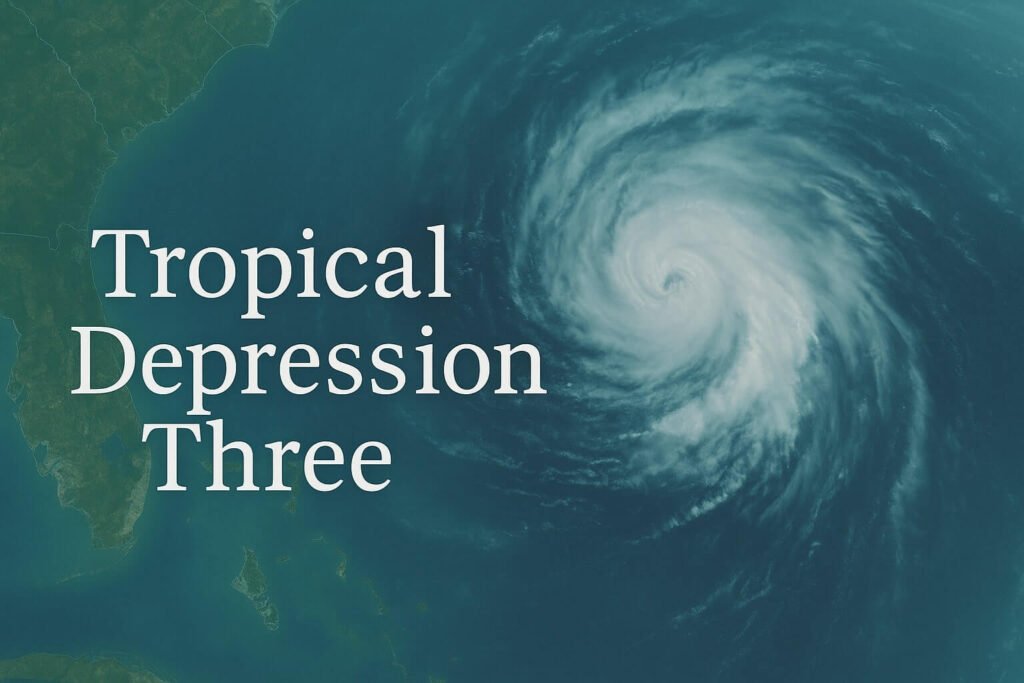The Atlantic hurricane season is heating up, and right now all eyes are on a newly formed tropical depression sitting off the southeastern coast of the United States. As of Saturday morning, Tropical Depression Three is slowly drifting northward in warm waters about 160 miles south-southeast of Charleston, South Carolina. It’s moving slowly, nearly stalled actually, but it’s doing exactly what forecasters have feared for weeks. It’s taking full advantage of the bath-like Gulf Stream waters and attempting to spin itself into Tropical Storm Chantal.
This is a situation where people could easily underestimate the threat. It’s not a giant Category 3 storm and it’s not coming in with headlines screaming devastation. But these slow, compact tropical depressions hugging warm coastal currents can still bring a punch. They often dump inches of rain over small areas, generate rip currents that can sweep swimmers away, and push minor storm surge into marshy, vulnerable zones.
Where the storm is right now
As of Saturday morning, the tropical depression was centered near 30.8° N and 78.6° W, with sustained winds of 35 mph and a central pressure of 1010 mb. The system is drifting slowly, almost aimlessly, north-northeast at just 2 mph. Its thunderstorm activity is lopsided, mostly building on the east side of the swirl, which is pretty typical for weak tropical cyclones struggling with wind shear.
Still, there are signs the system is organizing. Satellite images show deep bursts of convection flaring near and east of the center. A recent scatterometer pass even picked up wind speeds close to 32 knots, right at the threshold for tropical storm strength. The National Hurricane Center has issued a Tropical Storm Watch from Edisto Beach to Little River Inlet in South Carolina, which means tropical-storm-force winds are possible in the watch area within 48 hours.
This tropical depression is expected to strengthen slightly over the next 12 to 18 hours, possibly becoming Tropical Storm Chantal. Forecast models suggest a slow jog north or northwest into the South Carolina coast sometime Sunday morning. Once inland, it may turn northeast again and ride along or near the North Carolina coast by Monday.
What to expect along the coast
Even if it never quite gets named, this tropical depression has the ingredients to make this weekend tricky along the coast. Forecasters are warning of several key hazards:
Rainfall: The system is likely to dump 3 to 6 inches of rain along the central and northern South Carolina coast, with isolated spots seeing up to 8 inches. The rain will come in bands, which could sit over the same areas for hours, causing localized flooding in low-lying neighborhoods, marshes, and poorly drained urban zones.
Wind: Gusts of 40 to 50 mph are possible, especially near the immediate coast and in exposed areas like bridges and piers. While not hurricane-force, these winds can still knock down small branches and cause minor power outages, especially if soils become saturated from rain.
Storm Surge: With high tide, forecasters are expecting about 1 to 2 feet of coastal flooding, especially in areas with long, shallow sloping beaches or tidal creeks. Minor overwash on dunes is possible. This is not catastrophic surge, but enough to make conditions dangerous in vulnerable spots.
Surf and Rip Currents: The entire southeast coast from the Florida Space Coast to the Outer Banks of North Carolina will face dangerous rip currents and rough surf through Sunday and into Monday. Even experienced swimmers are urged to stay out of the water. Red flags are flying at many beaches and lifeguards may be forced to close access points depending on how rough conditions get.
Tornadoes: A few brief, weak tornadoes are possible in outer rainbands, particularly along the coastal Carolinas. These are usually quick and hard to predict, so residents should have a way to get alerts even at night.
Why this small storm still matters
It’s easy to look at a tropical depression and shrug it off. But that kind of thinking has led to dangerous outcomes before. We’ve seen tropical depressions flood highways, damage property, and cause drownings from rip currents and flash floods. Just because this isn’t a hurricane doesn’t mean it won’t have serious, real-life consequences.
It’s also important to note that this is only the third named system of the season so far, but it’s landing right on cue. Early-season storms in this part of the Atlantic basin often form from leftover fronts and warm coastal waters. The Gulf Stream is running about 1 to 2 degrees warmer than normal right now. That extra heat gives storms like this one the energy to rapidly spin up even with modest atmospheric support.
In this case, wind shear has been trying to disrupt the system, tilting its storms away from the center. But if that shear relaxes even a bit, we could see rapid strengthening over the next 12 hours. The forecast window is narrow, but not closed.
What to do now
If you’re in coastal South Carolina or southeastern North Carolina, now is the time to take simple precautions. Make sure your phones are charged, tie down anything that could blow away in gusts, and be ready for road closures if flooding occurs.
This isn’t a storm you need to evacuate for in most areas. But it’s a weekend-wrecker for sure, and anyone planning to head to the beach should rethink their plans.
Visitors staying in rental homes or beachfront condos should keep an eye on local alerts. In many cases, watches can be upgraded to warnings with little notice, especially with slow-moving systems like this one.
Looking ahead
Once the system moves inland Sunday, its core will likely weaken quickly. However, remnant moisture could feed storms across the Mid-Atlantic early next week. The threat shifts from coastal flooding to inland downpours, but the story continues.
Meanwhile, the broader Atlantic is beginning to look more active. Water temperatures across the Main Development Region are above average, and Saharan dust outbreaks are starting to ease. That means we may only be seeing the beginning of a much busier stretch in the Atlantic.
For now, though, the story is all about this stubborn little tropical depression sitting just off the South Carolina coast, testing the patience of meteorologists, beachgoers, and city planners. It may not make the evening news nationwide, but for the Carolinas, this is the storm to watch today and tonight.
Stay tuned to official forecasts, and if you’re in the watch zone, don’t wait for the name “Chantal” to take this system seriously.


